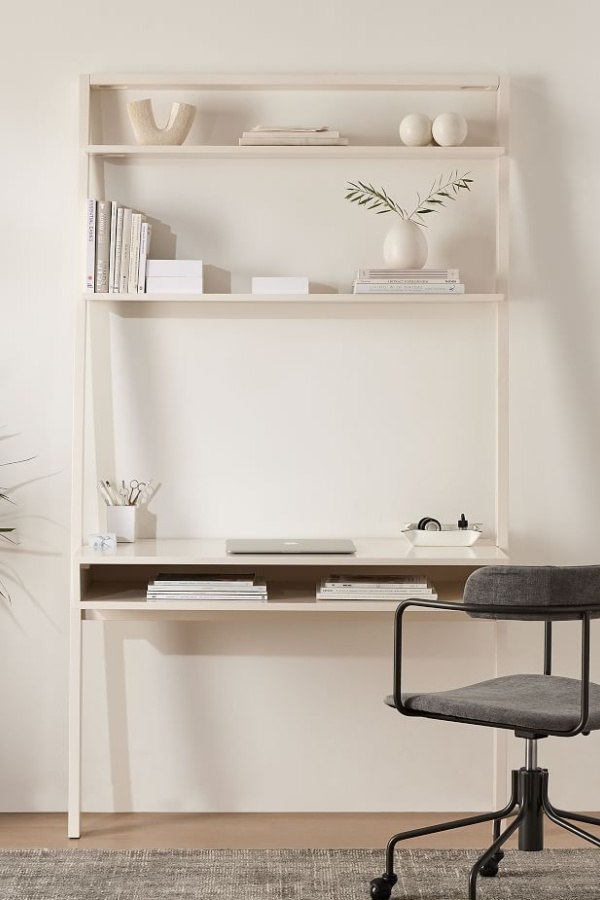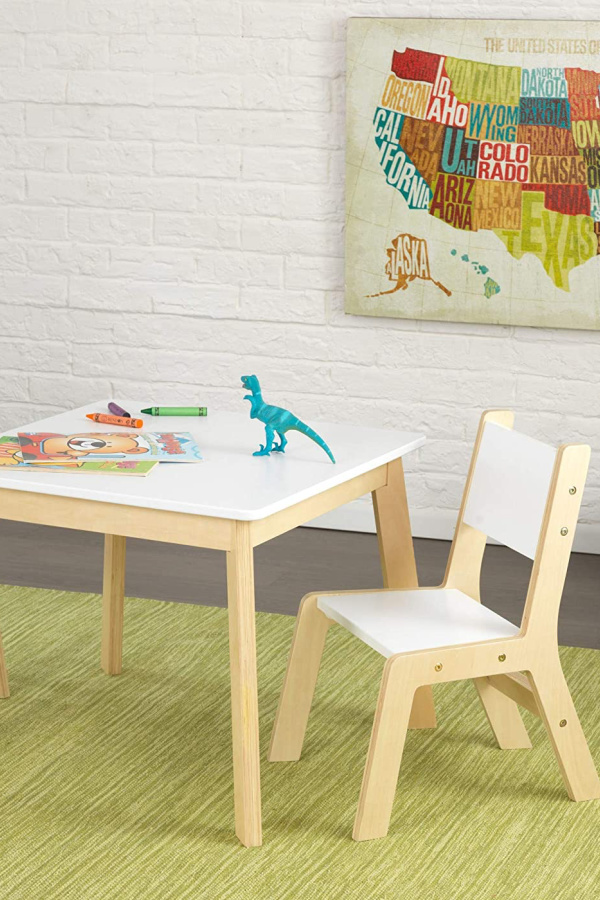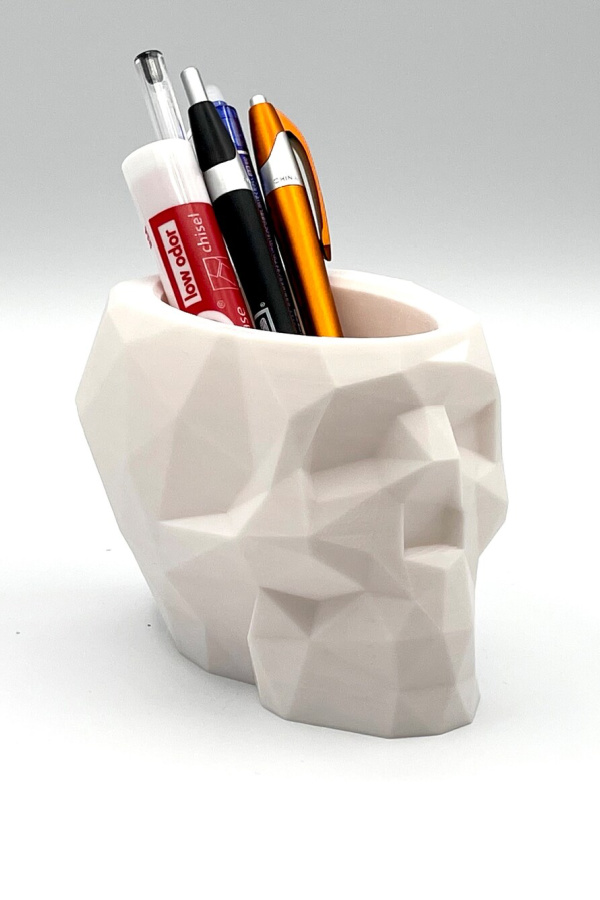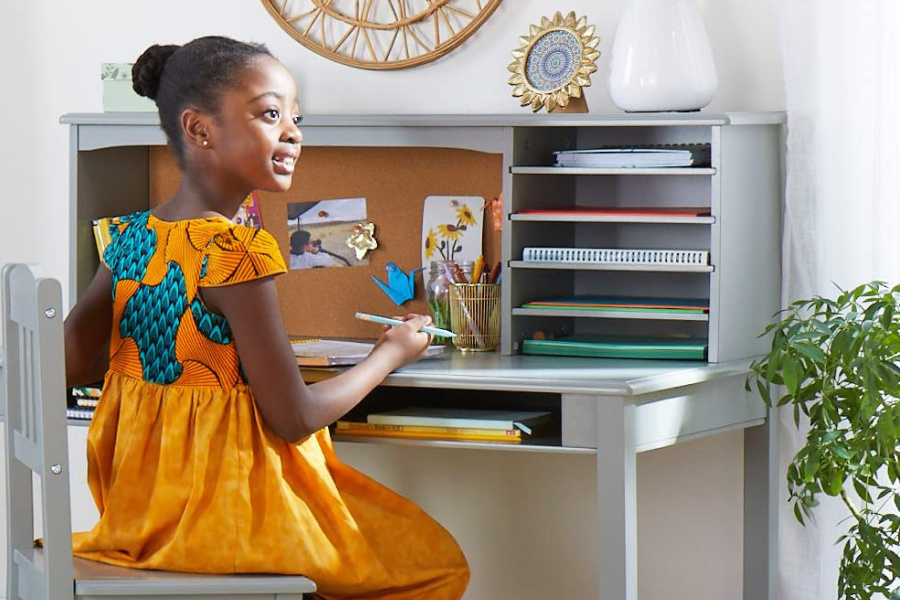So many parents have learned over the past few years that setting up a study space at home is more important than ever. Maybe you homeschool, maybe your kids just need a dedicated space for homework, or maybe they’ve got virtual tutoring or other extracurricular activities online, from home.
And while sure, a kitchen table setup has worked in smaller homes like mine years, if you can find even a small study space that your kids can call their own, I’ve found there are a lot of reasons to give it a shot.
So if setting up a study space at home is on your to-do list, I’m really happy to share my favorite tips, advice, and a few cool furniture recommendations.
Top image: Guidecraft Desks
This post contains affiliate links and some purchases may generate a small commission that helps support our team at no additional cost to you. This never impacts our independent recommendations.
– This post has been updated for 2023 –
Related: 20 cool backpacks for teens and older kids this year
Setting up a study space at home for your kids:
Tips to make it one your kids will love to use
Creating a dedicated study space at home for your kids has real benefits. In fact, I did loads of research about it even before the pandemic (data nerd that I am) when I finally ditched our own kitchen table textbook-takeover and got my two daughters some teen-appropriate desks from West Elm in their small shared room.
Giving kids their own study space helps kids actually focus better, keeps them organized (one less stress for us!), encourages independence, and even staves off arguments about space. Ask me how I know.
I’ve even read that when kids have their own study space, it helps them stay put longer, and whether they’re plowing through handwriting help or applying to colleges (eep!) clearly that’s a huge benefit.
Plus, letting kids set up a new study space can be a welcome, exciting change during the often stressful back-to-school season. It gives them a chance to express their own style, showing off who they are — or how they’ve changed and grew over the summer. And that’s not a small thing for kids.
 These are the ladder shelf desks I got from West Elm —
These are the ladder shelf desks I got from West Elm —
terrific for small spaces or shared rooms, easy to assemble, and have held up great.
1. Before you buy anything, list out your child’s academic needs
First of all, you want to make a list of what your kids really need in a study space, based on their grade level, their curriculum, and their school activities and expectations. In fact, check your school’s curriculum with this in mind, so you can get a sense of their academic load and upcoming projects and areas of study. (Homeschoolers, you’re in control here.) This will help you figure out what kind of desk, chair, storage, and other accessories you need.

For younger students, a classic kids play table and chair set like this one from KidKraft, is an affordable solution — under $80!
Plus, I love the quality of everything from KidKraft.
Will your child be coding, designing, or editing so that a desktop that accommodates a larger monitor is important? Is a computer printer something they use? Will they be practicing handwriting on actual paper? Printing out worksheets? Getting creative with construction paper and craft supplies? Using scientific calculators, compasses, and other devices for advanced math and science? Reading a ton of actual books — or will they be using Kindles, tablets, or other e-readers?
 This computer desk from Pottery Barn Kids comes with and without the hutch, so it can grow with your kids.
This computer desk from Pottery Barn Kids comes with and without the hutch, so it can grow with your kids.
If you first establish what kids need their at-home study space for, it helps you narrow down your furniture and accessory choices and makes the entire searching process so much easier. (It also ensures that they’ll have what they need so they’re not all up in your space, borrowing your stuff…or back at the kitchen table.)
Related: 13 dorm room essentials you might not have considered
2. Get creative with small spaces.
Living in an urban apartment, we don’t have a spare room or basement we can convert into a child’s work area or study space. If you do, more power to you! However if you have limited space — like really limited space — you’d be amazed with all the creative ways to help create functional work spaces in a smaller home. Plus keep in mind, kids really don’t need massive spaces to get work done. In fact, a smaller space may help them wrangle the clutter better to stay organized.
And hey, they still have the kitchen table for art projects or science experiments. It’s not like they’re limited to their desks all day long.
 I love this fold-up, wall-mounted laptop desk at Amazon for small spaces! Perfect for a laptop a few supplies, and knick-hacks.
I love this fold-up, wall-mounted laptop desk at Amazon for small spaces! Perfect for a laptop a few supplies, and knick-hacks.
And if you have teens, a big iced coffee tumbler ha.
A few items to look into when limited space is a consideration:
- a fold-up, wall-mounted laptop desk or floating desks that don’t take up floor space. Some even fold up at the end of the day
- a small corner desk (Target has a good selection) that can make use of an unused corner of a room
- a separate rolling laptop stand to add more surface area to a smaller desk you already own.
- a dual desk that seats two kids or puts them side by side — remember, lots of kids share tables or desks in classroom settings
- a desk with built-in storage like file cases or drawers
- -a desk that makes use of the full floor-to-ceilng space, like the ladder shelf desks, above, that I own, or a series of wall-mounted shelves instead of a bookcase on the ground.
- a loft bed with desk underneath like this beautiful one (below) from Wayfair in three colors.
- an ergonomic laptop stand to raise a laptop off a desk; add a Bluetooth keyboard instead of a larger laptop or monitor.
- a wall organizer or mounted cubbies instead of shelves, to give kids even more room for books and device storage without taking up valuable floor space.
- a sliding curtain or folding screen to create the illusion of a separate room when one isn’t available — this can be very helpful if you need to separate a small study space in the living room or a corner of the dining room.

3. Think comfort when it comes to children’s desk chairs — physically and mentally
Comfort is no small consideration when it comes to kids and their study space, and there are so many options now built ergonomically for kid-sized kids!
Start by considering the relationship of the desk to the chair. Apartment Therapy has a helpful article about finding the ideal height of a chair for the desk you have. When seated, their knees should be at a 90-degree angle to the ground but still fit under the desktop comfortably.
Then, consider what your child actually wants.
 This ergonomic desk chair isn’t too big for tweens and older kids. But if your kid is prone to fidgeting, skip the wheels.
This ergonomic desk chair isn’t too big for tweens and older kids. But if your kid is prone to fidgeting, skip the wheels.
My oldest daughter made a really big deal about wanting “a spinny chair” for some reason, and it’s something that makes her feel more comfortable. For a teen like her, you can invest in a higher end ergonomic desk chair — this one looks so grownup, and gets top ratings from thousands of buyers. But you really don’t have to spend a fortune. This desk chair is under $50 and so great looking!
But remember, comfort isn’t just about ergonomics and proper posture. It’s also about what makes a child feel comfortable mentally. So you want to be sure they have the kind of chair that they’re excited to sit in every day, whether it’s in their favorite color, upholstered in a fun fabric, or they get to cover it with stickers. (I know, deep breaths.)
Related: 5 ergonomic laptop accessories to make work at home healthier and easier on your body
4. Don’t make good lighting an afterthought.
We know that kids shouldn’t be reading in dim light. But there’s more to a desk lamp than that. If your child doesn’t have a ton of natural light in their desk area — or mayyyy be studying after daylight hours — you’ll definitely need a decent light, to keep kids’ eyes from getting tired.
Think about the shape of light that the lamp emits; a long, horizontal LED light will cast light across a larger space than a classic desk lamp with a standard bulb that emits more of a “spotlight” on a single area. Also, LED bulbs last longer and save energy.
You also want to think about how much desk space you’re taking up — in smaller spaces, consider a clip-on lamp, a wall mounted lamp, or hang a pendant lamp overhead from the ceiling.

And then there’s the light itself. One study indicates that cool light is more conducive to studying than warmer light. Who knew! With that in mind, one lamp in particular caught my eye: A multi-setting, Ottlite Wellness LED Desk Lamp designed to reduce eye strain and glare. Really!
5. Style is everything when you’re a kid. Shop accordingly.
 The Film Artist on Etsy creates wonderful minimalist graphic prints of fictional and real-life heroes like Malala —
The Film Artist on Etsy creates wonderful minimalist graphic prints of fictional and real-life heroes like Malala —
The perfect icon for a study space to remind kids about the value and importance of education.
A display of personal style in a study space is easily the most important factor of all — at least to your kids. So let them decorate their space with the hottest new Funko POP! figures, posters of a real life hero, affordable twinkle lights, a bulletin board covered with photos of friends, sports awards, Playbills, inspirational quotes, Marvel character artwork, a giant map of the world...whatever makes them happy.
My tip: try to say yes here more than you say no. A cool pencil holder? Yes! A funky braided USB cable? Great! A book of Across the Spiderverse posters ready for hanging? Absolutely!

My kids have a skull pencil holder like this one and love it!
More than a desk, more than a chair, decor and individual style is what helps kids feel like a space is “their own,” and can keep them happier, longer, and more inclined to spend time in their study space.
Also remember, there’s a social-emotional aspect to a kid’s decor as well. It says something about them. The space behind them will be visible in every Zoom call or video interaction, to every friend, grandparent, or tutor — and kids are hyper-aware of this, just the same as we are.
Not that there’s yet a Room Rater twitter account for kids’ rooms. Yet.





Your designs and ideas look incredible.. I will take few ideas from here to decorate my daughter’s room.. hope she will like it 🙂
Love the school bus desk! Since space is at a premium in my house, we found a small corner desk for both kids. So far so good!